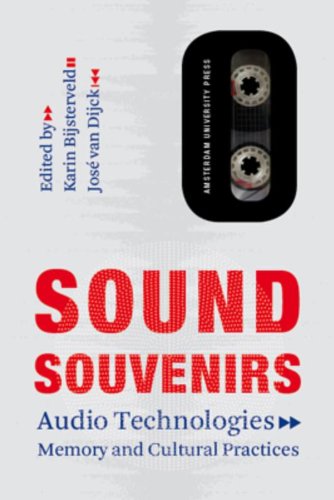Karin Bijsterveld, José van Dijck (eds.): Sound Souvenirs: Audio Technologies, Memory and Cultural Practices (2009)
Filed under book | Tags: · archive, memory, sound recording, technology

“In recent decades, the importance of sound for remembering the past and for creating a sense of belonging has been increasingly acknowledged. We keep “sound souvenirs” such as cassette tapes and long play albums in our attics because we want to be able to recreate the music and everyday sounds we once cherished. Artists and ordinary listeners deploy the newest digital audio technologies to recycle past sounds into present tunes. Sound and memory are inextricably intertwined, not just through the commercially exploited nostalgia on oldies radio stations, but through the exchange of valued songs by means of pristine recordings and cultural practices such as collecting, archiving and listing. This book explores several types of cultural practices involving the remembrance and restoration of past sounds. At the same time, it theorizes the cultural meaning of collecting, recycling, reciting, and remembering sound and music.”
Publisher Amsterdam University Press, Amsterdam, 2009
Transformations in Art and Culture series
Creative Commons BY-NC 3.0 License
ISBN 9089641327, 9789089641328
218 pages
PDF, PDF (updated on 2016-7-18)
Comment (0)Karin Bijsterveld: Mechanical Sound: Technology, Culture, and Public Problems of Noise in the Twentieth Century (2008)
Filed under book | Tags: · music, noise, psychoacoustics, sound recording, technology

“Since the late nineteenth century, the sounds of technology have been the subject of complaints, regulation, and legislation. By the early 1900s, antinoise leagues in Western Europe and North America had formed to fight noise from factories, steam trains, automobiles, and gramophones, with campaigns featuring conferences, exhibitions, and “silence weeks.” And, as Karin Bijsterveld points out in Mechanical Sound, public discussion of noise has never died down and continues today. In this book, Bijsterveld examines the persistence of noise on the public agenda, looking at four episodes of noise and the public response to it in Europe and the United States between 1875 and 1975: industrial noise, traffic noise, noise from neighborhood radios and gramophones, and aircraft noise. She also looks at a twentieth-century counterpoint to complaints about noise: the celebration of mechanical sound in avant-garde music composed between the two world wars.
Bijsterveld argues that the rise of noise from new technology combined with overlapping noise regulations created what she calls a “paradox of control.” Experts and politicians promised to control some noise, but left other noise problems up to citizens. Aircraft noise, for example, measured in formulas understandable only by specialists, was subject to public regulation; the sounds of noisy neighborhoods were the responsibility of residents themselves. In addition, Bijsterveld notes, the spatial character of antinoise interventions that impose zones and draw maps, despite the ability of sound to cross borders and boundaries, has helped keep noise a public problem. We have tried to create islands of silence, she writes, yet we have left a sea of sounds to be fiercely discussed.”
Publisher MIT Press, 2008
ISBN 0262026392, 9780262026390
350 pages
Keywords and phrases
Anti-Noise, decibel, industrial noise, dB, National Physical Laboratory, noise abatement, Dutch, Netherlands, Art of Noises, earplugs, player piano, gramophone, World Soundscape Project, Trevor Pinch, Rotterdam, North Brabant, ICAO, Barry Truax, psychoacoustics, Breda
PDF (updated on 2021-4-11)
Comment (0)Aden Evens: Sound Ideas: Music, Machines, and Experience (2005)
Filed under book | Tags: · digital culture, music, sound, sound recording, sound synthesis, technology

As record collectors and file swappers know, the experience of music—making it, marketing it, listening to it—relies heavily on technology. From the viola that amplifies the vibrations of a string to the CD player that turns digital bits into varying voltage, music and technology are deeply intertwined.
What was gained—or lost—when compact discs replaced vinyl as the mass-market medium? What unique creative input does the musician bring to the music, and what contribution is made by the instrument? Do digital synthesizers offer unlimited range of sonic potential, or do their push-button interfaces and acoustical models lead to cookie-cutter productions? Through this interrogation of sound and technology, Aden Evens provides an acute consideration of how music becomes sensible, advancing original variations on the themes of creativity and habit, analog and digital technologies, and improvisation and repetition.
Sound Ideas reinvents the philosophy of music in a way that encompasses traditional aspects of musicology, avant-garde explorations of music’s relation to noise and silence, and the consequences of digitization.
Published by University of Minnesota Press, 2005
ISBN 081664537X, 9780816645374
203 pages
PDF (updated on 2012-8-3)
Comment (0)
